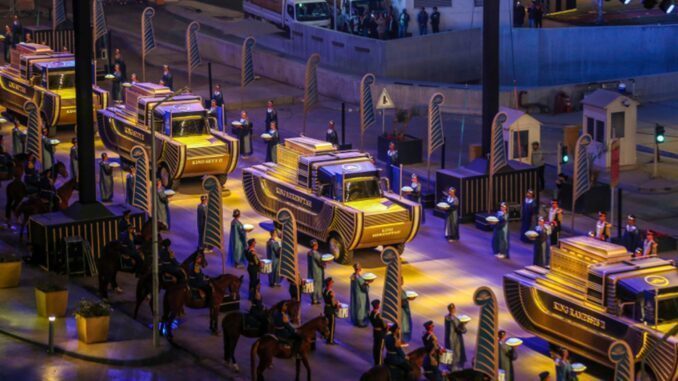
A procession of floats carrying the mummified remains of mummified remains of 18 kings and four queens, including Egypt’s most powerful ancient queen, snaked through Cairo on Saturday evening in an eye-catching parade to a new resting place.
Under heavy security, the mummies travelled seven kilometers (four miles) across Egypt’s capital to the new National Museum of Egyptian Civilization.
In what was dubbed the “Pharaohs’ Golden Parade”, the 18 kings and four queens travelled in order, oldest first, each aboard a separate float decorated in ancient Egyptian style.
Both pedestrians and vehicles were barred from Tahrir Square, site of the current museum, and other sections of the route for the parade.
Images of the parade and a carefully choreographed opening ceremony were broadcast live on state television, to rousing music.
“With great pride, I look forward to welcoming kings and queens from Egypt after their trip,” Egypt’s Abdel Fattah al-Sisi said on Twitter just ahead of proceedings.
“This grandiose spectacle is further proof of the greatness … of a unique civilization that extends into the depths of history,” he added.
Seqenenre Tao II, “the Brave”, who reigned over southern Egypt some 1,600 years before Christ, was on the first chariot, while Ramses IX, who reigned in the 12th century BC, brought up the rear.
Another great warrior, Ramses II, who ruled for 67 years, and Queen Hatshepsut, the most powerful female pharaoh, were also on the journey.
The gold-colored carriages were fitted with shock absorbers for the 40-minute trip, to ensure none of the precious cargos are accidentally disturbed on Cairo’s roads.
Discovered near Luxor from 1881 onwards, the mummies continue to reveal fascinating new details of the pharaohs’ lives – and deaths.
A high-tech study of Seqenenre Tao II, involving CT scans and 3D images of his hands and long-studied skull fractures, indicate he was likely killed in an execution ceremony, after being captured in battle.
For their procession through Cairo’s streets, the mummies were placed in special containers filled with nitrogen, under conditions similar to their regular display cases, Egyptian archaeologist Zahi Hawass said, according to France 24.
“I am delighted that the mummies will find a new home in the Civilization Museum, where they will be displayed for educational and civilization purposes, and not for amusement as they were in the Egyptian Museum,” he said.
“I am certain the parade will capture the hearts of people everywhere,” Hawass added.
The new resting place, the National Museum of Egyptian Civilization in the Fustat district of Old Cairo, consists of sleek, low-rise buildings topped with a pyramid amid expansive grounds.
The mummies will undergo 15 days of laboratory restoration before they are showcased individually in their new home, in an environment redolent of underground tombs.
The “museum has what it takes to preserve (mummies), the best laboratories … it is one of the best museums we have,” Waleed el-Batoutti, advisor to the tourism and antiquities ministry, told state television.
The National Museum of Egyptian Civilization opened its doors to limited exhibits from 2017 and will open fully on Sunday, before the mummies go on display to the general public from April 18.
In the coming months, the country is due to inaugurate another new showcase, the Grand Egyptian Museum, near the Giza pyramids.
It too will house pharaonic collections, including the celebrated treasure of Tutankhamun.
Discovered in 1922, the tomb of the young ruler, who took the throne briefly in the 14th century BC, contained treasures including gold and ivory.
A so-called “curse of the pharaoh” emerged in the wake of Tutankhamun’s unearthing in 1922-23.
A key funder of the dig, Lord Carnarvon, died of blood poisoning months after the tomb was opened, while an early visitor likewise died abruptly in 1923.
With the parade coming only days after several disasters struck Egypt, some inevitably speculated on social media about a new curse provoked by the latest move.
The past days have seen a deadly rail collision and a building collapse in Cairo, while global headlines were dominated by the struggle to refloat the giant container ship MV Ever Given which blocked the Suez Canal for almost a week.
The mummies’ re-housing “marks the end of much work to improve their conservation and exhibition,” said UNESCO Director-General Audrey Azoulay, who was in Cairo for the parade.
“This raises emotions that go much further than the mere relocation of a collection – we will see the history of Egyptian civilization unfold before our eyes.”
What a night!
The “Pharaohs’ Golden Parade” was broadcast live on the country’s state-run television and other satellite stations, as well as on official social media platforms.
Salima Ikram, head of the Egyptology unit at the American University in Cairo, told Al Jazeera the spectacle was “extremely moving”.
“In a way, people are very proud of what they are seeing,” she said. “So, although there was great expense, I think the return may be quite good in the long run.”
Archaeologist Nigel Hetherington shared the enthusiasm. “What a night, absolutely amazing – just wants to make you be in Egypt,” he said, according to Al Jazeera .
“When these mummies were moved to the museum in the first place after their discovery, of course we’ve got photographs and the rest of it, but it’s not the same as actually witnessing. It’s truly a momentous occasion,” said Hetherington.
“You can imagine that they’ve been working on it a very long time and I think they’ve pulled it off – there was the spectacle, but we also felt that everything was done safely; obviously these are irreplaceable royal ancestors, so every care had to be taken.”
Most of the mummies belong to the ancient New Kingdom, which ruled Egypt between 1539 BC to 1075 BC, according to the ministry of antiquities.
They included Ramses II, one of the country’s most famous pharaohs, and Queen Hatshepsut, Egypt’s only woman pharaoh – who wore a false beard to overcome tradition requiring women to play only secondary roles in the royal hierarchy.
The mummies were originally buried some 3,000 years ago in secret tombs in the Valley of Kings and the nearby Deir el-Bahri site. Both areas are near the southern city of Luxor. The tombs were first excavated in the 19th century.
After excavation, the mummies were taken to Cairo by boats that sailed the Nile. Some were showcased in glass cases, while others were stored.
The remains of Ramses II were taken to Paris in 1976 for intensive restoration work by French scientists.
The made-for-TV parade was part of Egypt’s efforts to attract foreign tourists by publicising its ancient artefacts.
The tourism industry has been reeling from political turmoil following the 2011 popular uprising that toppled longtime autocrat Hosni Mubarak, and more recently, the coronavirus pandemic.
“With great pride, I look forward to welcoming kings and queens from Egypt after their trip,” Egypt’s Sisi posted on Twitter shortly before the proceedings took place.
“This grandiose spectacle is further proof of the greatness … of a unique civilization that extends into the depths of history,” he added.
The parade circled Tahrir Square, where authorities officially unveiled an obelisk and four sphinxes to now decorate Cairo’s most famous square.
“Again, Egypt dazzles the world with an unrivalled event,” said film star Hussein Fahmy in an official promotional video.
Once at the new museum, 20 of the mummies will be displayed, while the remaining two will be stored, according to the ministry.



